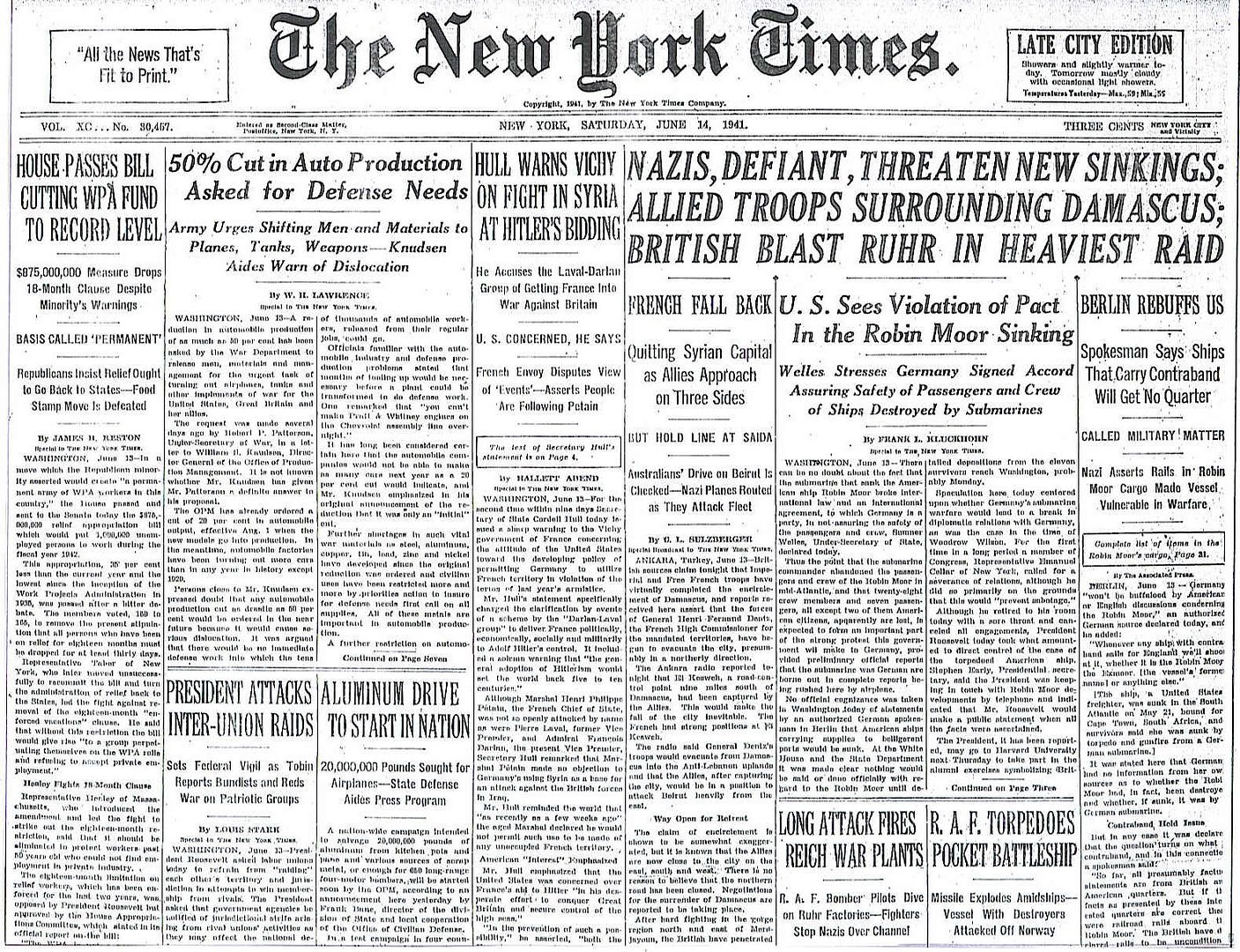
Posted on 06/14/2011 4:46:21 AM PDT by Homer_J_Simpson

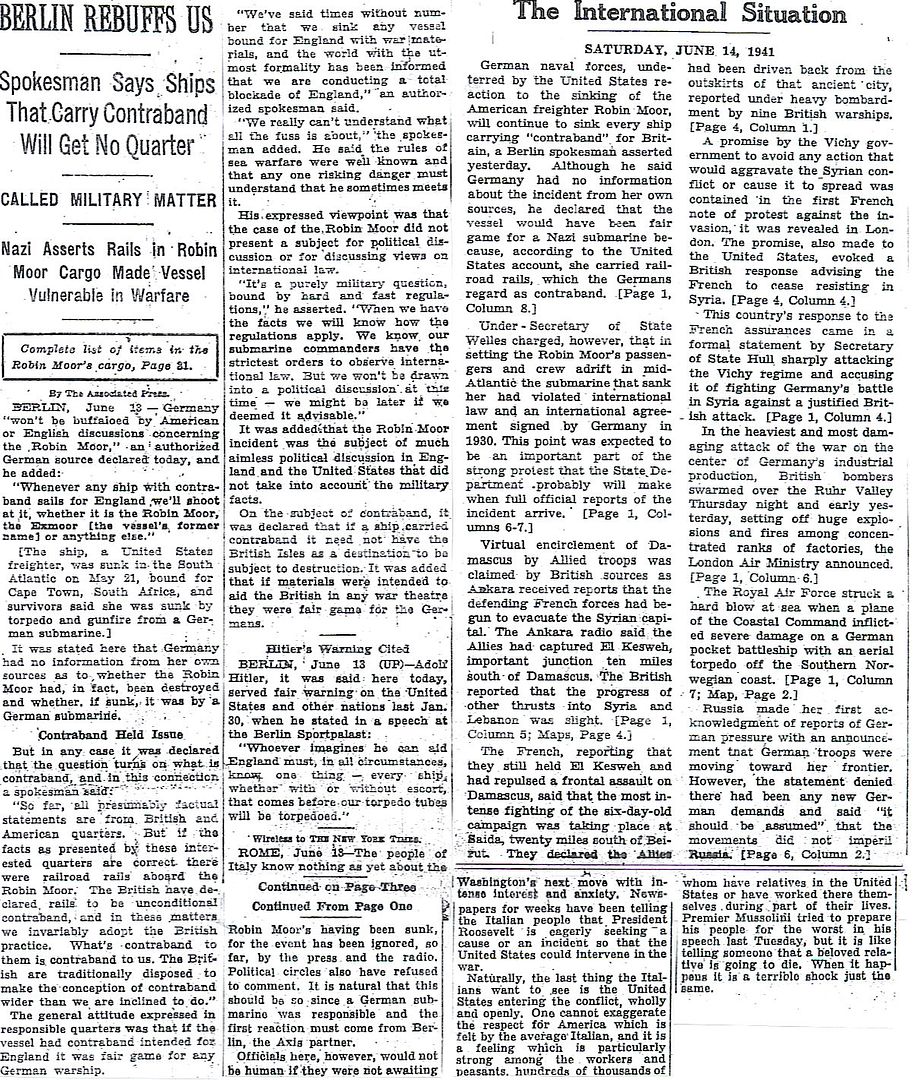
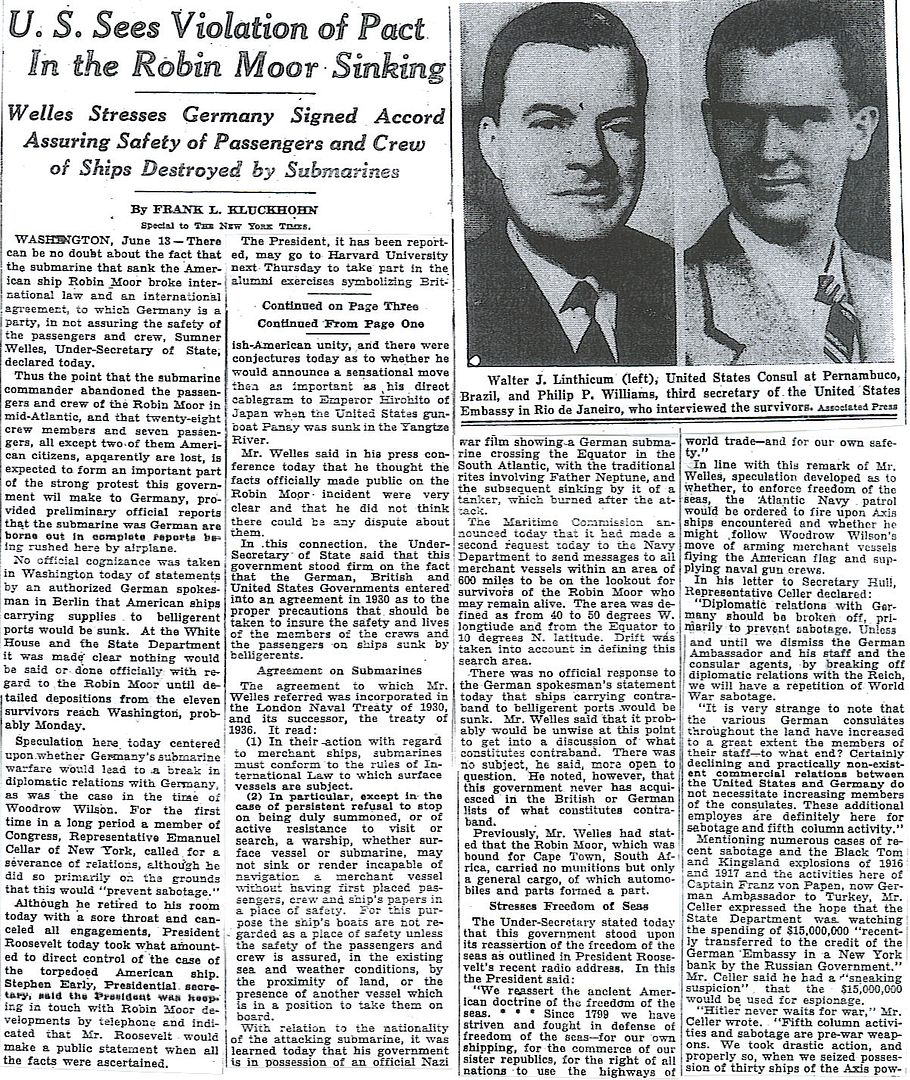
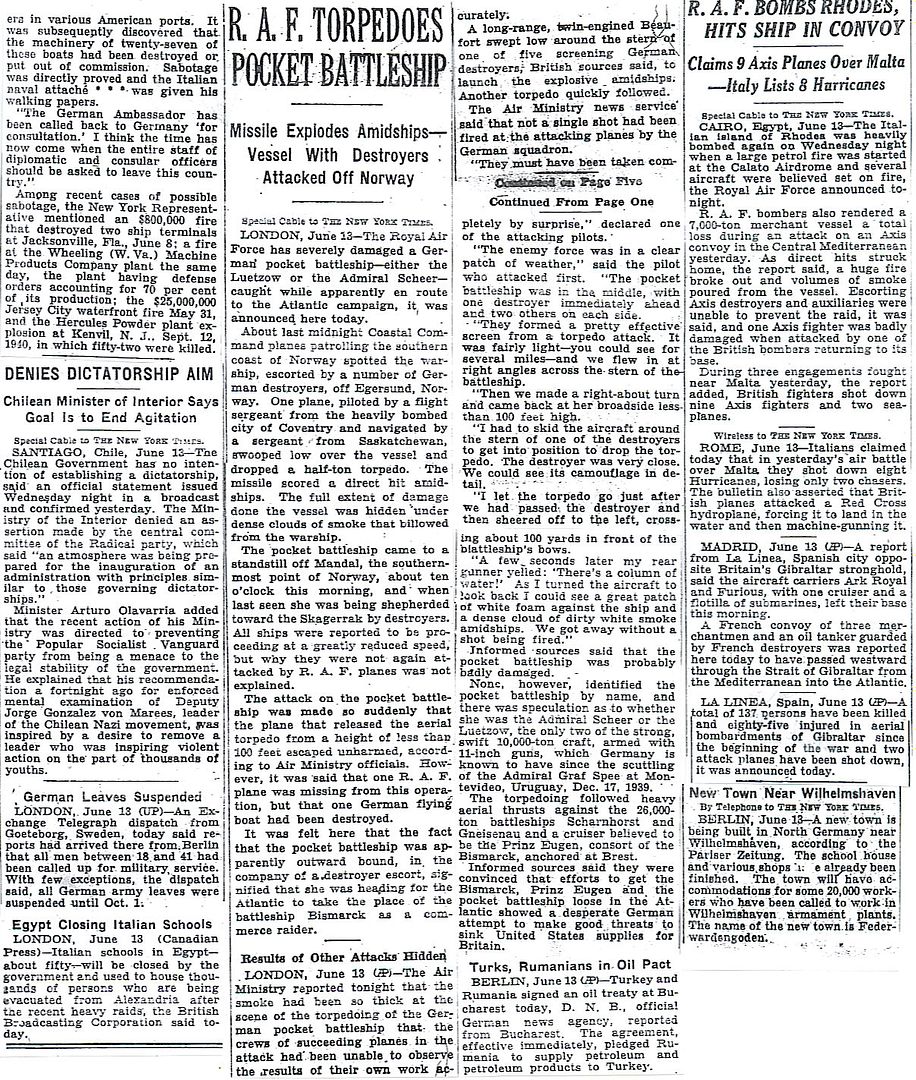
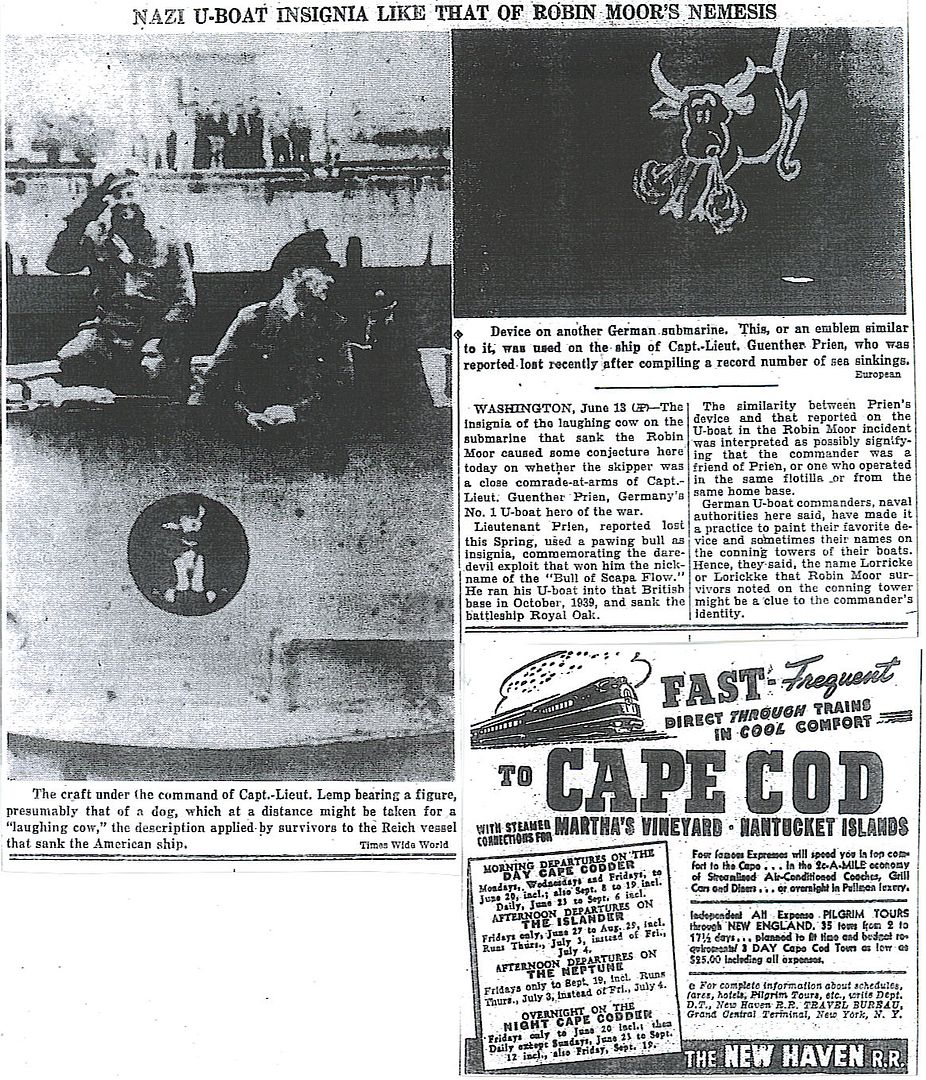
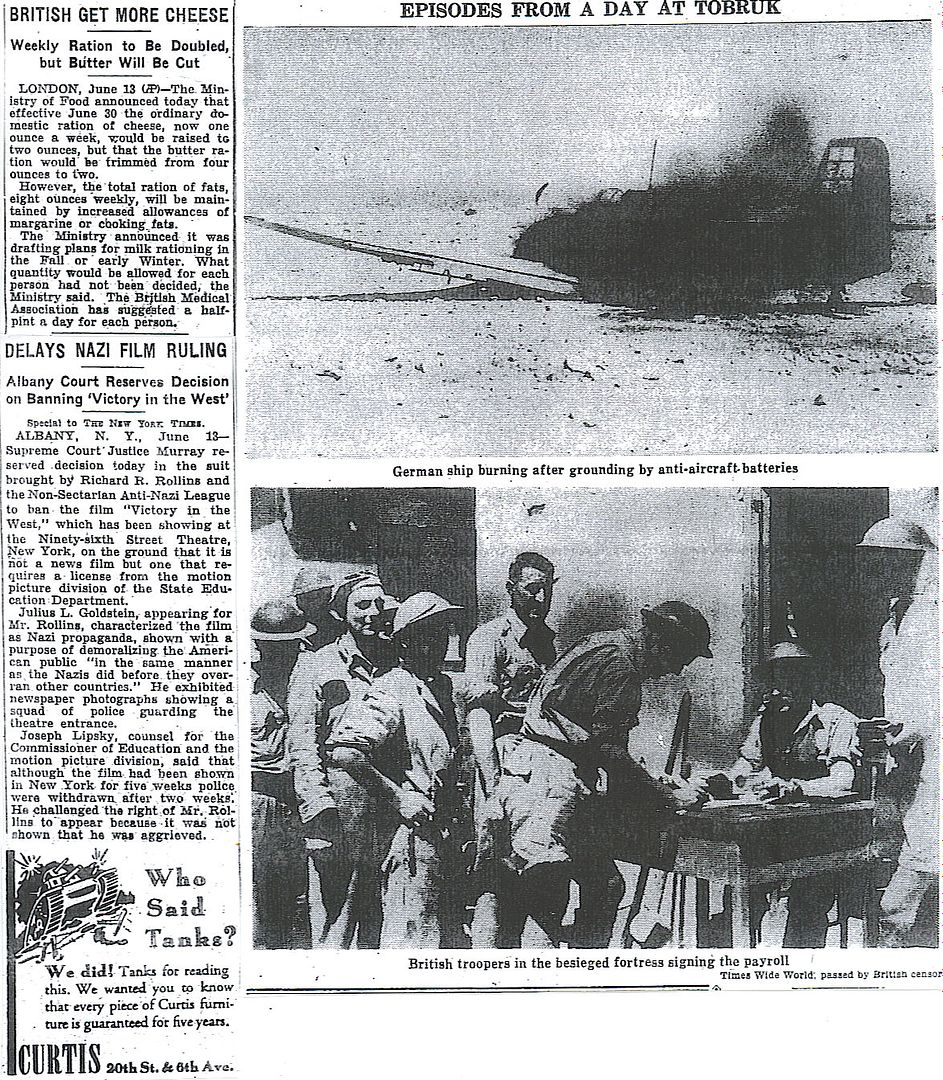

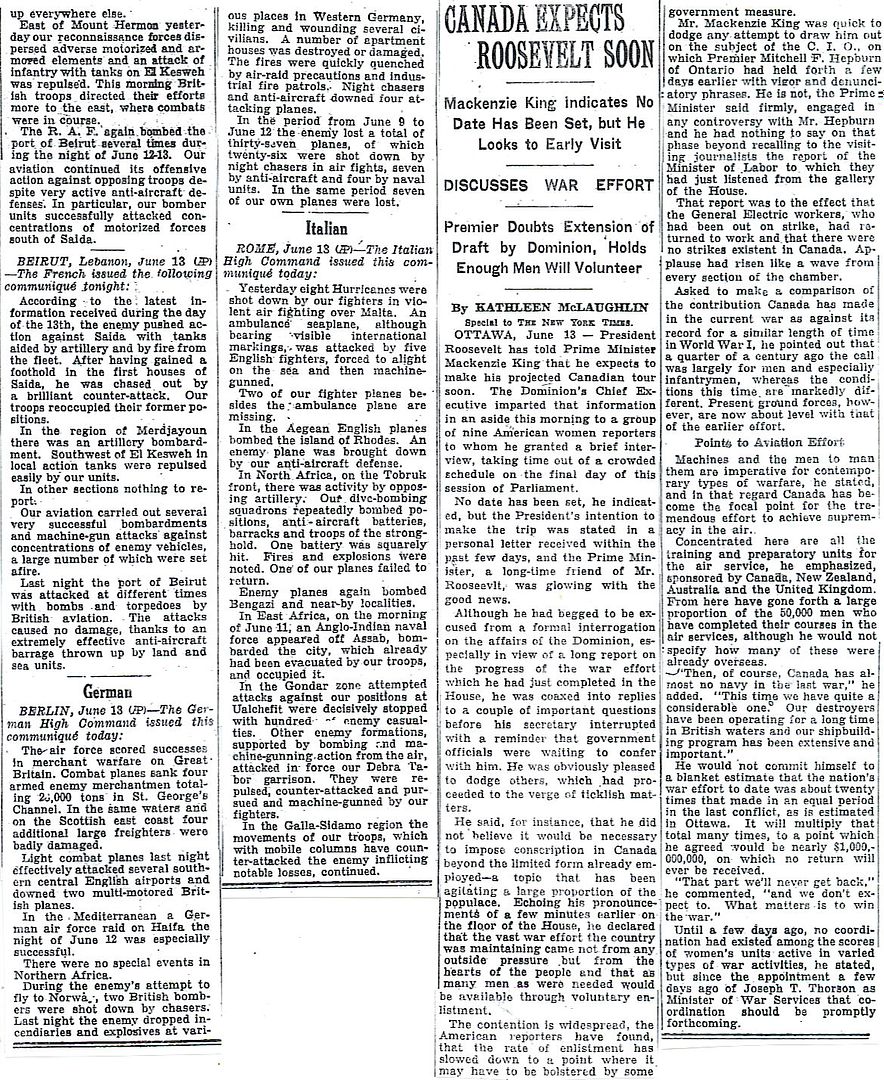
#1 - “Maria Elena” - Jimmy Dorsey, with Bob Eberly
#2 - “Maria Elena” – Wayne King
#3 - “Daddy” - Sammy Kaye, with the Kaye Choir
#4 - “My Sister And I” - Jimmy Dorsey, with Bob Eberly
#5 - “Intermezzo” – Wayne King
#6 – “Amapola” ((Pretty Little Poppy) - Jimmy Dorsey, with Bob Eberly and Helen O’Connell
#7 - “Dolores” – Bing Crosby and the Merry Macs
#8 – “The Hut-Sut Song” – Freddy Martin, With Eddie Stone
#9 - “The Hut-Sut Song” – Horace Heidt, with Donna & her Don Juans
#10 – “The Band Played On” - Guy Lombardo, with the Kenny Gardner Trio
http://www.onwar.com/chrono/1941/jun41/f14jun41.htm
US freezes German and Italian assets
Saturday, June 14, 1941 www.onwar.com
From Washington... President Roosevelt freezes all German and Italian assets in the United States.
In the Mediterranean... The carriers Ark Royal and Victorious fly another cargo of Hurricanes to Malta. Of the 47 sent 43 arrive.
http://homepage.ntlworld.com/andrew.etherington/month/thismonth/14.htm
June 14th, 1941
FRANCE: A year ago the Germans occupied Paris. A humiliating surrender was only days away. Twelve months later, despite the acquiescence of the pro-Nazi regime in Vichy, there are signs that resistance is beginning to stir in occupied France.
A coal-miners’ strike has just ended in the Pas-de-Calais region, which cost the Germans 500,000 tons of coal. 100,000 miners downed tools on 26 May, shouting “No coal for the enemy” and paralysing two entire regions.
This show of strength, along with the student demonstration in Paris in 11 November, is the most spectacular resistance action France has yet seen. But so far the Resistance lacks both finances and organisation within France. Most would-be resistants prefer to work alone or in small groups.
The circles of intellectuals, like the famous group ‘Musee de l’Homme’ which suffered severe losses in February, prefer to hand out pamphlets or clandestine newspapers. Others have opted for concrete action, like sabotaging some military installations, storing weapons, helping Jewish prisoners to escape and organising uprisings.
Paul Koepfler managed to help 120 people escape to the south on Christmas Eve; soon after he was arrested by the Germans. The risks are extremely high, regardless of the type of resistance chosen - especially since informing on one’s neighbours is encouraged by the Vichy rulers.
Many French citizens oppose the enemy by means of individual gestures, like placing flowers at the ‘Arc de Triomphe’ or tearing up German posters. Despite the arrests, the torture and the deportation awaiting the resistance, the number of people joining the resistance movement continues to grow.
GERMANY: Commander Theodore Eicke of the SS Death’s Head division informs his officers of Hitler’s “Commissar” order to kill all Communist officials on sight.
U-303, U-414 laid down.
U-333 launched. (Dave Shirlaw)
U.S.S.R.: Moscow: The foreign minister, Vyacheslav Molotov, says that “only a fool would attack Russia.”
Arrests begin after Soviet Union occupied Estonia in July 1940, but they are made quietly. There were about 7,000 people arrested before 14 June, mostly Estonian politicians, high level officers and others whom the Communists considered dangerous. (Rainer Korsen)
MEDITERRANEAN SEA: HMS Ark Royal and HMS Victorious bring more Hurricane fighters to Malta.
LIBYA: Wavell launches Operation Battleaxe, which has as its aim the destruction of Rommel’s forces and to achieve a decisive victory in North Africa. If all else failed the attack might at least relieve Tobruk. The attack was to be led by the new commander of 13 Corps. Lt-General Beresford-Pierse, who had replaced the captured General Neame.
To achieve this aim, the British had to capture the old frontier posts at the Halfaya Pass, Fort Capuzzo and Sollum in the first attack. This would be achieved by the Indian 4th Division with the Matilda tanks of the 4th Armoured Brigade in close support. Once they had succeeded in penetrating the enemy line, 7th Armoured would come forward, join with 4th Armoured and break through to Tobruk. This done, 7th Armoured, now reinforced by the Tobruk garrison, would push on and secure a line along the axis between Derna and Mechili. Wavell estimated that Rommel had 13,000 men and 100 tanks close to the wire with another 25,000 men and 200 tanks around Tobruk, 80 miles to the west.
The true figures were that the British had 300 assorted tanks to Rommels 200, of which only about 100 were the gun-armed PzKw IIIs and IVs. But Rommel had prepared a defensive line and moved all his anti-tank forces forward, including 88mm guns, which could easily penetrate the thick armour of the Matildas.
SYRIA: 25 Aust Brigade captures Jezzine after long truck journey from Merdjayoun to the coast. On the eastern axis French in Kiswe continue to resist fiercely. Eight Ju-88s of Italian Air Force attack British warships off Tyre. Tomahawks of 3 Sqn RAAF claim three Ju-88s shot down. (Michael Alexander)
AUSTRALIA: Minesweeper HMAS Lithgow commissioned. (Dave Shirlaw)
CANADA: Minesweeper HMCS Lachine launched Levis, Province of Quebec.
NEWFOUNDLAND: Depot ship HMS Forth arrived St John’s and joined NEF until replaced by HMS Greenwich in September. (Dave Shirlaw)
U.S.A.: Washington:
The sinking of the American freighter Robin Moor by a German U-boat decided President Roosevelt to freeze Axis assets in the United States. Naval activity here is hectic. Two destroyers were launched yesterday in Boston. Large cargo ships are being converted into escort carriers capable of launching 15 aircraft, and Congressmen believe that the next step will be to arm merchantmen.
Germany and Italy have taken measures with a view to freezing US assets, said to be worth GBP 105 million in Germany and GBP 36 million in Italy.
The first tests of the launcher, rocket antitank, T1, codenamed “The Whip”, this is later known as the bazooka. (Pat Holscher)
Destroyers USS Fitch and Forrest launched.
Destroyers USS Doran and Earle laid down. (Dave Shirlaw)
ATLANTIC OCEAN: SS St Lindsay sunk by U-751 at 51N, 30W. (Dave Shirlaw)
http://worldwar2daybyday.blogspot.com/2011/06/day-653-june-14-1941.html
Day 653 June 14, 1941
Operation Exporter. British destroyers HMS Jervis and HMS Griffin bombarded Sidon, Lebanon, in support of Australian 7th Division. 2 French destroyers emerge from Beirut at 4.20 PM to engage but are chased off by New Zealand cruiser HMNZS Leander and the destroyers. 8 German Ju88s try to bomb the British warships but they are engaged by 8 Curtiss P-40 Tomahawks of 3 Squadron Royal Australian Air Force, flying from airfields in Palestine, which shoot down 3 Ju88s.
Operation Battleaxe. CIC Middle East General Wavell believes incorrectly that Rommel has most of his armour engaged in the siege of Tobruk. During the day, British armour, reinforced with tanks from the Tiger convoy, moves forward in Egypt to within 25 miles of German positions on the Libyan border. In fact, Rommel has the newly arrived 15th Panzer Division on the border and he orders up reinforcements when he learns of the British movement, leaving 5th Light Division to prevent any break out from Tobruk. Overnight, German artillery bombard Tobruk.
At 3.46 AM 700 miles West of Ireland, U-751 sinks British SS St. Lindsay (all 34 crew, 5 gunners and 5 Royal Navy passengers are lost). South of Sardinia, British submarine HMS Clyde sinks Italian SS Giovanni Bottigliere.
Operation Tracer. British aircraft carriers HMS Ark Royal and HMS Victorious, escorted by cruiser HMS Renown and 7 destroyers, sail from Gibraltar and fly off 47 Hurricane fighters to Malta. Only 43 Hurricanes arrive safely.
http://www.globalsecurity.org/military/systems/ground/bazooka-1.htm
In prewar America, a West Point ordnance officer, Maj. Leslie A. Skinner, was responsible for the Army’s rocket program. The Army had assigned him to its new rocket research group of the National Defense Research Committee in Washington, DC, in 1940. Money for projects never filtered down, however, nor did guidance as to what he was supposed to develop. Skinner benefited from the work of Robert H. Goddard. Unlike Goddard, who had demonstrated a rocket gun at the end of World War I, Skinner and Edward G. Uhl unveiled their invention at a more opportune time. In a private workshop, on their own time, the pair created the bazooka, the first workable US military-produced rocket. Uhl, a recent graduate of Lehigh University, had a thorough grounding in physics and engineering. Despite Hickman’s high interest, the Army rocket program remained a relatively low priority with a miniscule budget. Uhl, for example, would first search the Powder Factory’s scrap heap whenever he needed some metal. While rummaging through the scrap pile behind his workshop, Uhl came upon a 5-foot length of metal pipe that proved just wide enough to accept a 60-mm. round.
Within months of U.S. involvement in World War II, the Army adopted, produced and fielded the 2.36-inch-diameter, shoulder-fired anti-tank rocket and tube launcher. The first troops to receive it called it “the Buck Rogers gun.”
At the first test firing of the rocket grenade, the firing tube was dubbed the bazooka after the humorous musical instrument which entertainer Bob Burns had fashioned from two gas pipes and a funnel in the 1930s. Suggestions that it was named because of the sound it made when fired appear less well established. Topps developed its Bazooka Bubble Gum product in Brooklyn, New York after World War II ended. Bazooka is also famous for the popular series of Bazooka Joe comics, first introduced in 1953 to add extra interest for youngsters.
Initially known only under the code name of THE WHIP, the bazooka was a shoulder projector launching an effective 2.36-inch antitank rocket. For the first time in history a foot soldier had a weapon specifically designed to penetrate armor. The rocket included the hollow-charge antitank principle. The destructive power of the combat arms — infantry, armor, and artillery — greatly increased in World War II. Infantry carried its own antitank weapons in the form of the American 2.36 inch Bazooka rocket launcher.
I like the scene in Band of Brothers where a lieutenant volunteers an enlisted man to help him stop a German tank headed for their position. The EM doesn't much like the plan but they get the job done, putting a round from their bazooka into the underside of the tank as it climbed over a hump.
One item from my notes today:
The last major conference prior to operation BARBAROSSA takes place at the Reich Chancellery in Berlin. In this meeting Hitler re-emphasizes his belief that the destruction of Russia will compel Britain to seek terms for peace. He also makes it known that more than the acquisition of land, this battle is for the destruction of Bolshevism.
This is more on this in the excerpt from Shirer's book in reply #3 above.
Disclaimer: Opinions posted on Free Republic are those of the individual posters and do not necessarily represent the opinion of Free Republic or its management. All materials posted herein are protected by copyright law and the exemption for fair use of copyrighted works.